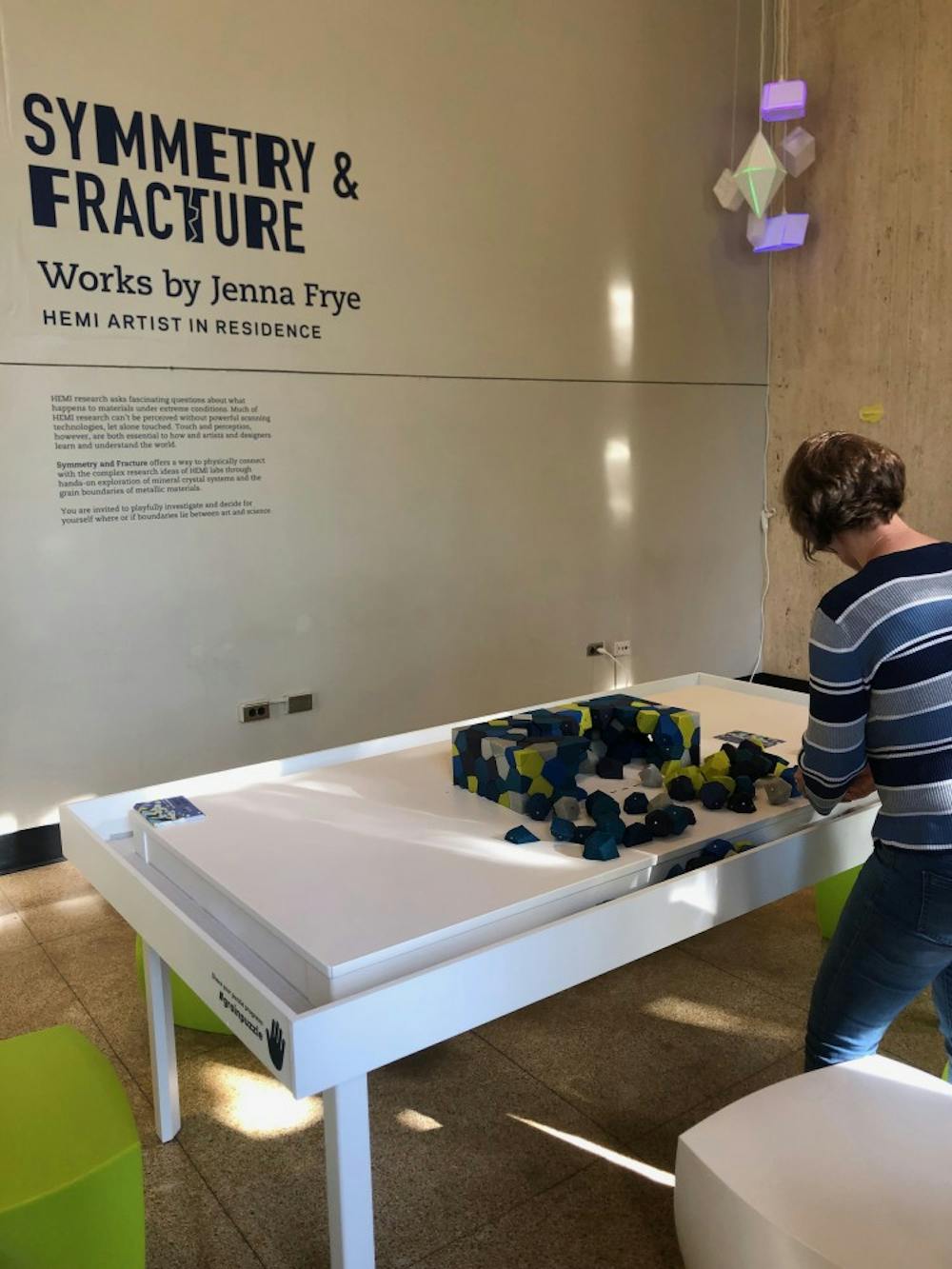A new installation on display at Hopkins challenges the boundary between science and art. Jenna Frye, the creator of the exhibit Symmetry and Fracture, is a full-time faculty member at the Maryland Institute College of Art (MICA) and artist in residence at the Hopkins Extreme Materials Institute (HEMI).
The installation was unveiled on Sept. 26 and is on view in Q-level of the Milton S. Eisenhower (MSE) Library. The collection consists of pieces with which attendees can interact directly. Students are urged to try their hand at the grain boundary puzzle — a complex assemblage of intricate pieces that fit together perfectly but are difficult to assemble. Also included in the exhibit are samples of minerals attached to a board with a magnifying glass and 3D-printed foam lamps shaped to resemble the crystal structure of different minerals.
All of the pieces are models of the actual structures of different materials, enlarged so their details are more visible to the human eye. Symmetry and Fracture highlights the work being done at HEMI in a tangible way so that the general population can more easily understand it.
When asked about her inspiration for the project, Frye explained that it was rooted in her collaboration with HEMI, especially the meetings she had with colleagues and classes that she helped to teach.
Frye elaborated on the freedom she had to explore different areas within materials science.
“Essentially it was whatever I was interested in. Sometimes I was interested in the visual pattern and sometimes something else. Everything is the fundamental of something else,” Frye said.
The installation lies at the intersection of art and science, with chemical principles depicted aesthetically in a visual manner. Frye explained that she enjoys working at the boundary between the two fields.
“In the art world, people ask, ‘Are you an artist or a designer?’ And I will say yes. I’m interdisciplinary,” Frye said.
The main goal of this specific project for Frye was interactive learning. She elaborated on what she aims for visitors to get out of their experience.
“I’m hoping that people get a sense of what I would call embodied learning, meaning when you put your hands on something, whether it’s a mineral or a piece of fabric or a piece of 3D printing, you learn something by touching it,” Frye said.
She found enlarged models of miniscule structures to be helpful to her own understanding of extreme materials, and the characteristics of minerals. To be able to fully illustrate the complexity of a material sample of copper, Frye created the grain boundary puzzle.
In order to get the grain symmetry of the sample just right for her finished piece, Frye spent over 600 hours perfecting the puzzle. For those who are particularly ambitious, the file for the impossible puzzle and all other pieces in the exhibit are available on Frye’s website for free download. Also included on the site are instructions for how to print and construct the pieces.
Anil Kotte and Justin Leeb, both seniors studying Economics, tried their hands at solving the grain puzzle.
Kotte explained that it was not an easy task.
“It’s actually really difficult. I’ve been trying to experiment with different pieces, but there are so many variabilities and options that it’s kinda hard,” Kotte said. “I don’t know if there’s a strategy to solving it. We were trying to look at the edges and stuff, but it definitely would take a long time.”
Leeb agreed, highlighting that this was not an everyday puzzle.
“Regular puzzles seem a lot easier when you look at something like this,” Leeb said.
Frye acknowledged the complexity of the piece and urged Hopkins students to rise to the occasion.
“The challenge is on for JHU to put it back together. I want to see if y’all can do it,” Frye said.
Campbell Knobloch, a senior studying both Spanish and Earth and Planetary Sciences, was impressed with the way the exhibit demonstrates how everything in the world is made up of smaller things that dictate its structure and function.
“Minerals are the perfect example where the final thing that you see is so clearly a reflection of its smaller structure,” Knobloch said.
When asked about her future plans, Frye explained that she hopes to continue working on projects with a similar goal.
“I want to keep going with concrete things people can do, exercises, things they can make, that combine art and science in a real way,” Frye said. “Not like, ‘Oh, I’m going to draw a picture of an amoeba.’ Something that’s real embodied learning.”
For students interested in working or studying at the intersection of science and art, Frye explained that persistence is necessary, as the journey will not be an easy one.
“My advice is don’t give up. If you don’t see the space for yourself — and P.S., you won’t — you make that space,” Frye said. “When I started school I was studying medicine, and then I switched to art and teaching, and I’ve found the spot for myself. Those spots are out there, and you just have to keep going and don’t give up.”
Symmetry and Fracture will be on display in until Jan. 10, 2020.





